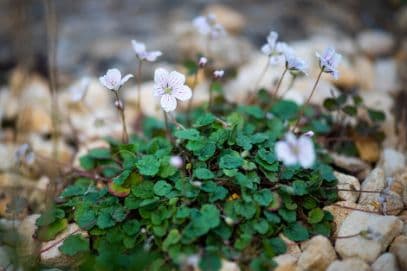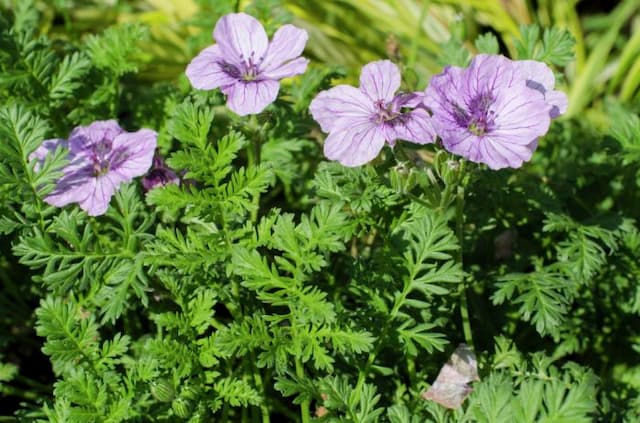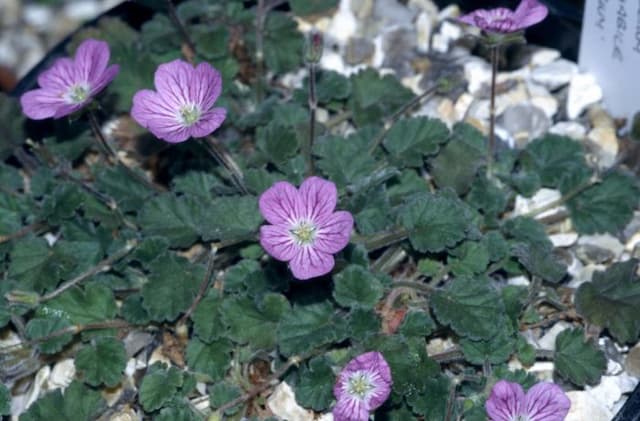Geranium Pelargonium 'Berkswell Flair' (A)

ABOUT
Pelargonium 'Berkswell Flair' is a visually compelling variety of geranium. It boasts a lush foliage with leaves that are delicately serrated and may present with hints of zoning, which exhibits darker coloration following the shape of the leaf. The leaves are generally a bright, vibrant green, providing a perfect backdrop for the stunning blooms. The flowers of the 'Berkswell Flair' emerge in impressive clusters, known as umbels, and are noted for their striking appearance. Each flower within the cluster comprises rounded petals that unfurl elegantly from a centralized point. The color of the blooms is a particularly eye-catching feature - typically displaying a rich, deep hue of pink or magenta, with distinctively marked petals that are often adorned with darker, contrasting streaks or feathering that radiate from the center. This variegated pattern adds depth and visual interest to the overall bloom. Adding to its charm, the flowers may exhibit subtle shading or gradation, with the intensity of color potentially softening as it stretches toward the petal's edges, giving a lovely, delicate effect. The blooms provide a stark and beautiful contrast to the foliage and can be particularly showy when the plant is in full flower, creating a focal point in any garden display or when grown as a potted specimen. The geranium exudes a classic, yet somewhat romantic aesthetic, making it a favored choice for both ornamental gardens and container gardening.
About this plant
 Names
NamesFamily
Geraniaceae.
Synonyms
Berkswell Flair Geranium, Berkswell Flair Pelargonium.
Common names
Pelargonium 'Berkswell Flair'
 Toxicity
ToxicityTo humans
Pelargoniums, commonly known as geraniums, are not generally considered highly toxic to humans. However, some people may experience mild irritation or an allergic reaction after handling the plants or ingesting parts of it. Ingesting large quantities can potentially lead to gastrointestinal discomfort, including nausea, vomiting, and diarrhea. It is generally recommended to keep plants out of the reach of young children who might chew on them.
To pets
Geraniums, such as the Pelargonium 'Berkswell Flair', can be toxic to pets if ingested. The toxicity is mainly due to the presence of geraniol and linalool, which are found in the essential oils of the plant. Symptoms of geranium poisoning in pets can include vomiting, diarrhea, lethargy, depression, anorexia, and dermatitis in some cases. Cats are particularly sensitive to the toxic effects, and it's advisable to prevent access to these plants for the safety of your pets. If you suspect your pet has ingested geranium, contact your veterinarian promptly.
 Characteristics
CharacteristicsLife cycle
Perennials
Foliage type
Evergreen
Color of leaves
Green
Flower color
Pink
Height
1-2 feet (30-60 cm)
Spread
1-2 feet (30-60 cm)
Plant type
Herb
Hardiness zones
9
Native area
South Africa
Benefits
 General Benefits
General Benefits- Ornamental Appeal: The Pelargonium 'Berkswell Flair' offers vibrant and colorful blooms that enhance the visual appeal of gardens and living spaces.
- Low Maintenance: This plant is relatively easy to care for, requiring minimal upkeep, making it ideal for both novice and experienced gardeners.
- Drought Tolerance: Once established, it is fairly resistant to drought, reducing the need for frequent watering.
- Versatility: Suitable for growing in pots, containers, and borders, it offers flexibility in garden design and location.
- Attracts Pollinators: The flowers can attract bees and butterflies, which are beneficial for pollination and the health of the garden ecosystem.
- Long Flowering Period: Pelargoniums typically have an extended blooming period which ensures color in the garden for a good part of the year.
- Fragrance: Some Pelargonium varieties emit a pleasing scent which can add an aromatic dimension to garden spaces.
 Medical Properties
Medical PropertiesThis plant is not used for medical purposes.
 Air-purifying Qualities
Air-purifying QualitiesThis plant is not specifically known for air purifying qualities.
 Other Uses
Other Uses- Potpourri - The leaves and flowers of Pelargonium can be dried and added to potpourri mixes to provide a pleasant fragrance.
- Aromatic Oils - The essential oils from Pelargonium can be used for making scented candles, soaps, and other aromatherapy products.
- Cooking - The edible flowers and leaves can be used to flavor sugars, desserts, jellies, and cakes, bringing a unique taste to culinary creations.
- Decoration - The colorful blossoms of Pelargonium can be used to decorate plates or as garnish, adding an attractive touch to meals.
- Crafts - The flowers and leaves can be incorporated into crafts, such as handmade papers, to add natural beauty and fragrance.
- Insect Repellent - The plant's scent is known to be a natural deterrent to some insects, so placing them around outdoor seating areas can help repel pests.
- Clothing Freshener - Dried Pelargonium leaves can be placed in drawers or closets to impart a fresh scent to clothing and linens.
- Natural Dye - The flowers can be used to make a natural dye for fabrics, offering an eco-friendly alternative to synthetic dyes.
- Artistic Inspiration - Artists and photographers often use the striking flowers of Pelargonium as subjects in their work, drawing inspiration from their vibrant colors and forms.
- Edible Landscaping - Pelargonium 'Berkswell Flair' can serve both an aesthetic and functional role in gardens that favor both beauty and utility.
Interesting Facts
 Feng Shui
Feng ShuiThe Geranium is not used in Feng Shui practice.
 Zodiac Sign Compitability
Zodiac Sign CompitabilityThe Geranium is not used in astrology practice.
 Plant Symbolism
Plant Symbolism- Comfort and healing: Pelargonium, commonly known as geranium, often symbolizes comfort and the plant's pleasant fragrance and medicinal properties relate to healing and feelings of solace.
- Friendship and happiness: Geraniums are also associated with positive emotions and can represent both friendship and the simple joy of happiness in everyday life.
- Harmony and balance: The balanced, rounded shape of geranium flowers and their reliable growth convey a sense of stability and harmony in one's environment.
- Protection: Geraniums have been used historically to ward off evil spirits, and are still considered a symbol of protection against negative influences.
 Water
WaterGeraniums, such as the Pelargonium 'Berkswell Flair', should be watered thoroughly when the soil feels dry to the touch, which typically means watering every 7 to 10 days depending on the climate and indoor conditions. Provide enough water to soak the soil through to the drainage holes, which might be approximately half a gallon for a medium-sized pot. During the growing season in spring and summer, they may need more frequent watering, while in winter, the watering frequency should be reduced. It's important not to let geraniums sit in soggy soil, so ensure proper drainage and allow the top inch of soil to dry out before watering again.
 Light
LightGeraniums prefer bright, indirect light and will thrive in a spot that receives at least 6 to 8 hours of sunlight daily. Direct morning light is beneficial, but afternoon sun in hot climates can be too intense, so a location with some afternoon shade is ideal. Ideally, place your Pelargonium 'Berkswell Flair' near an east or west-facing window to meet its light requirements.
 Temperature
TemperatureGeraniums are best kept in temperatures between 65 and 75 degrees Fahrenheit during the day, and they should not be exposed to temperatures below 55 degrees Fahrenheit, as they are not frost-tolerant. They can tolerate up to around 80 degrees Fahrenheit without much harm, but prolonged exposure to high heat may adversely affect their health. Make sure your Pelargonium 'Berkswell Flair' is in a location where the temperature remains consistent and within its preferred range.
 Pruning
PruningPrune geraniums to promote bushy growth and to remove dead or yellowing leaves and spent blooms. This should be done periodically throughout the growing season, with a more thorough pruning in early spring. For the Pelargonium 'Berkswell Flair', cut back leggy stems to about one-third their length, and snip right above a leaf node to encourage new growth. Pruning just before the growing season kicks off gives the plant a fresh start and helps maintain a desirable shape.
 Cleaning
CleaningAs needed
 Soil
SoilGeranium 'Berkswell Flair' thrives in a well-draining potting mix with equal parts peat, perlite, and compost. It prefers a slightly acidic to neutral pH, ranging from 6.0 to 7.0, to promote optimal growth.
 Repotting
RepottingGeranium 'Berkswell Flair' generally needs repotting every one to two years, or when it outgrows its container, to ensure continued health and blooming.
 Humidity & Misting
Humidity & MistingGeranium 'Berkswell Flair' does well in average room humidity conditions and does not require any special humidity adjustments for optimal growth.
 Suitable locations
Suitable locationsIndoor
Place Geranium 'Berkswell Flair' near a sunny window and water when soil feels dry.
Outdoor
Grow Geranium 'Berkswell Flair' in pots with drainage holes and place in full to partial sun.
Hardiness zone
9-11 USDA
 Life cycle
Life cycleGeranium 'Berkswell Flair' begins its life cycle when a seed germinates, typically in early spring, requiring warmth and moisture to trigger growth. The seedling emerges with its first set of true leaves and continues to develop a root system and foliage through the vegetative stage. As temperatures rise, the plant enters the flowering stage, producing vibrant blooms that attract pollinators and are characteristic of the cultivar. After pollination, flowers may develop into fruit, which contains seeds that eventually mature and, when conditions are right, can be dispersed to begin a new cycle. During autumn or when conditions become unfavorable, the plant may enter dormancy, reducing growth and conserving energy. In some climates, the geranium may be perennial, resuming growth in the spring, or it may be treated as an annual, completing its life cycle within one growing season.
 Propogation
PropogationPropogation time
Spring-Early Summer
The Pelargonium 'Berkswell Flair', commonly known as a type of geranium, can be propagated by stem cuttings, which is the most popular method for this plant. To propagate by cuttings, take a 4-6 inch (10-15 cm) cutting from a healthy parent plant during the active growing season, ideally in late spring to early summer. Ensure the cutting has at least three leaf nodes. Strip the bottom leaves and dip the cut end in rooting hormone powder to encourage root development. Then, place the cutting in a pot with well-draining potting soil, perlite, or vermiculite, and keep it moist but not waterlogged. Provide bright, indirect light and maintain a temperature between 70-75°F (21-24°C). Roots typically form within a few weeks, after which the new geranium can gradually be acclimatized to more direct light and eventually transplanted outdoors if desired.




![Cranesbill [Blue Sunrise]](/_next/image?url=https%3A%2F%2Fplants-admin.emdemapps.com%2Fimages%2Fplants%2F%2Fimages%2F604b638d45948.png&w=640&q=75)




